Means of Payment in Latin America: evolution and opportunities
![]() 20 minutes reading
20 minutes reading
We all need to keep pace with the evolution of means of payment. But why is that? Well, when the way we make transactions changes, society itself also changes. In this article we’re going to show how this happens in practice, based on the current scenario in the six biggest economies in Latin America: Argentina, Brazil, Chile, Colombia, Mexico, and Peru.
Although the low rate of banking of the population and the heavy reliance on cash as a payment method are still a reality in the region, everything is changing very fast and therefore you have to prepare for what's to come.
To support all those businesses keen to keep pace with the developments and opportunities in this market and offer their customers the best experience, Dock, through its Research area, developed a wide-ranging study of the topic, drawing on a variety of secondary data sources.
This research gave rise to our study Lands of Opportunities – A map for means of payment and digital banking in Latin America. Below are a few of the key insights from the study. Check it out!
What are means of payment?
As we know, means of payment are different ways people can pay for products or services. Among them are debit and credit cards, cash, Pix, between others. To address this concept, it is important to make a brief historical rescue and understand how we got here.
Everything began thousands of years ago with the barter system. As society, trade, and technology evolved, the concept became much broader, evolving from exchanges of agricultural produce to metal coins and, much later, paper money, which was created in the seventeenth century.
Today, when we talk about the concept and the various resources used to pay for something, we already have a completely different image. It is much more common to think of new payment methods and in all the different possibilities that the market offers – and that keep increasing.

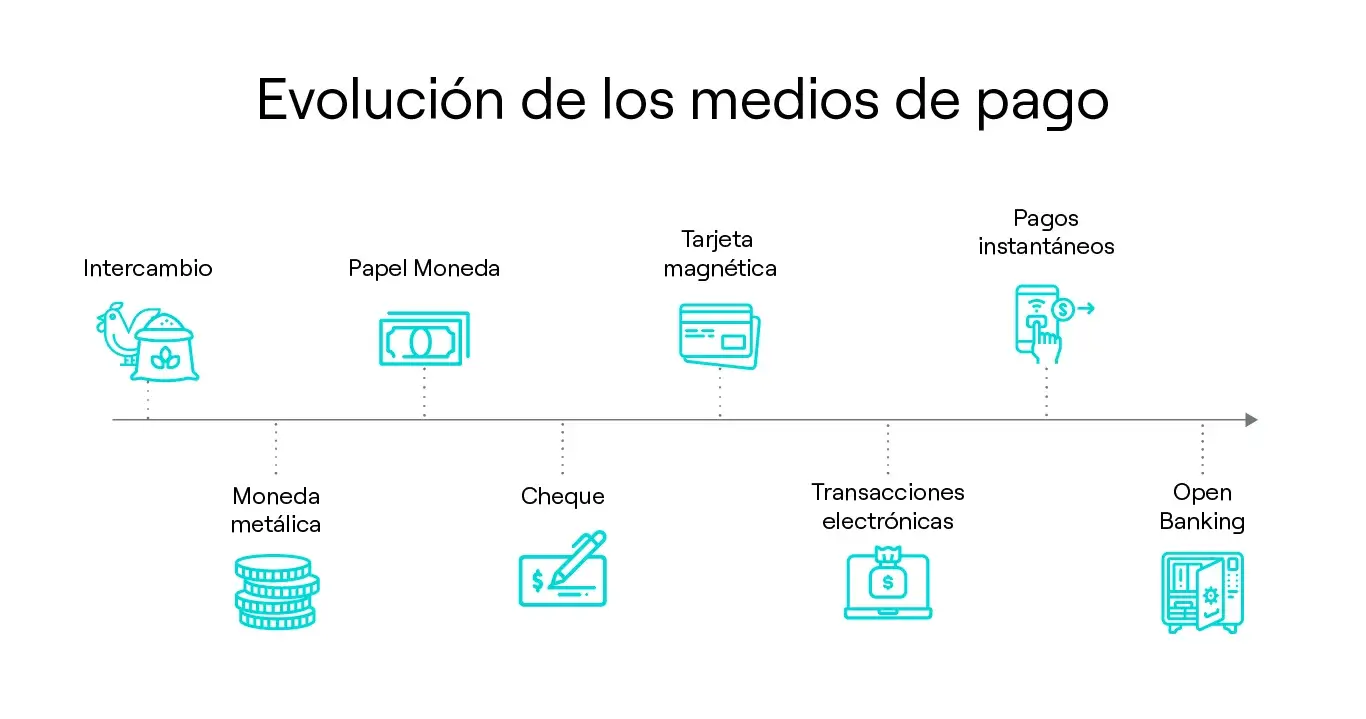
What means of payment are there?
Although cash is still the most widespread form of payment in Latin America – used in 70% of all transactions – there are now many other ways to pay for things.
Digital payment methods have taken great strides in recent years, and were also given a strong impetus during the Covid-19 pandemic and with the adoption and expansion of online habits. This means that the percentage of cash transactions is likely to decline in the region and that Latin Americans will increasingly turn to new methods to pay for their purchases.
Below we explain the different means of payment available, dividing them into the ones that are consolidated and the ones that are on the up.
Traditional means of payment most used in Latin America
Cash
Paper money is still the payment of choice for the majority of Latin Americans.
So much so that even 14% of online purchases are still paid for using cash. The cash payment is either made upon delivery of the product, or it is enabled by vouchers, which are generated by e-commerce merchants and paid in convenience stores or banks.
Check
While checks may look like a thing of the past, the fact is that until just a few years ago, they were a leading form of payment in several Latam countries. Nowadays, checks are in decline, losing much ground to credit and debit cards, and they are no longer universally accepted in commercial establishments.
Credit and debit cards
After the money card is the other major player in the means of payment in Latin America. Since its inception, it has been very popular and we have seen a growing adhesion of establishments and consumers to credit and debit payments.
In recent years, cards have evolved with technology and, today, in addition to chip cards and machines with easy access for merchants, it is also possible to charge by cell phone and use the approach payment.
Barcoded bills
This kind of payment is relatively common in Latin America, because the payer does not need a bank account – an important feature, given the region’s large unbanked population. The business establishment issues the barcoded bill and the consumer can pay it at a lottery store, a bank, or the establishment itself.
The future of means of payment in Latin America: trends and opportunities
So far, we’ve looked at more traditional forms of payment that are well established in the Latin American market. But we also want to look at the ones that are just beginning to gain currency and could turn out to be game changers in the near future, offering great market opportunities.
Instant payments
Based on the recent experience in Brazil – successful implementation, adherence and volume transacted by the Pix,in addition to other successful cases around the world; it is possible to say that instant payments are promising in the region.
However, different countries are at different stages of development when it comes to instant payments. A few examples:
- Brazil: success with the central bank’s Pix instant payment system, facilitating financial transactions with operations taking no more than 10 seconds to clear. It’s operated using a token – the user’s cell phone number, email address, etc. – and works 24/7.
- Chile: a system similar to Pix is in the pipeline, but what is currently available is a 24/7 wire transfer system with almost immediate clearance, without the use of any token or QR code.
- Argentina: Tranferencias 3.0, rolled out in November 2021, has had good uptake since.
- Mexico: launched CoDi in 2019, a digital payment platform that offers QR code payment, NFC technology, links, and text messages, in a bid to curb the population’s cash habit.
- Peru and Colombia: private-sector initiatives only, not systems produced by the central bank. Even so, recent trends and predictions point to increased uptake and system evolution.

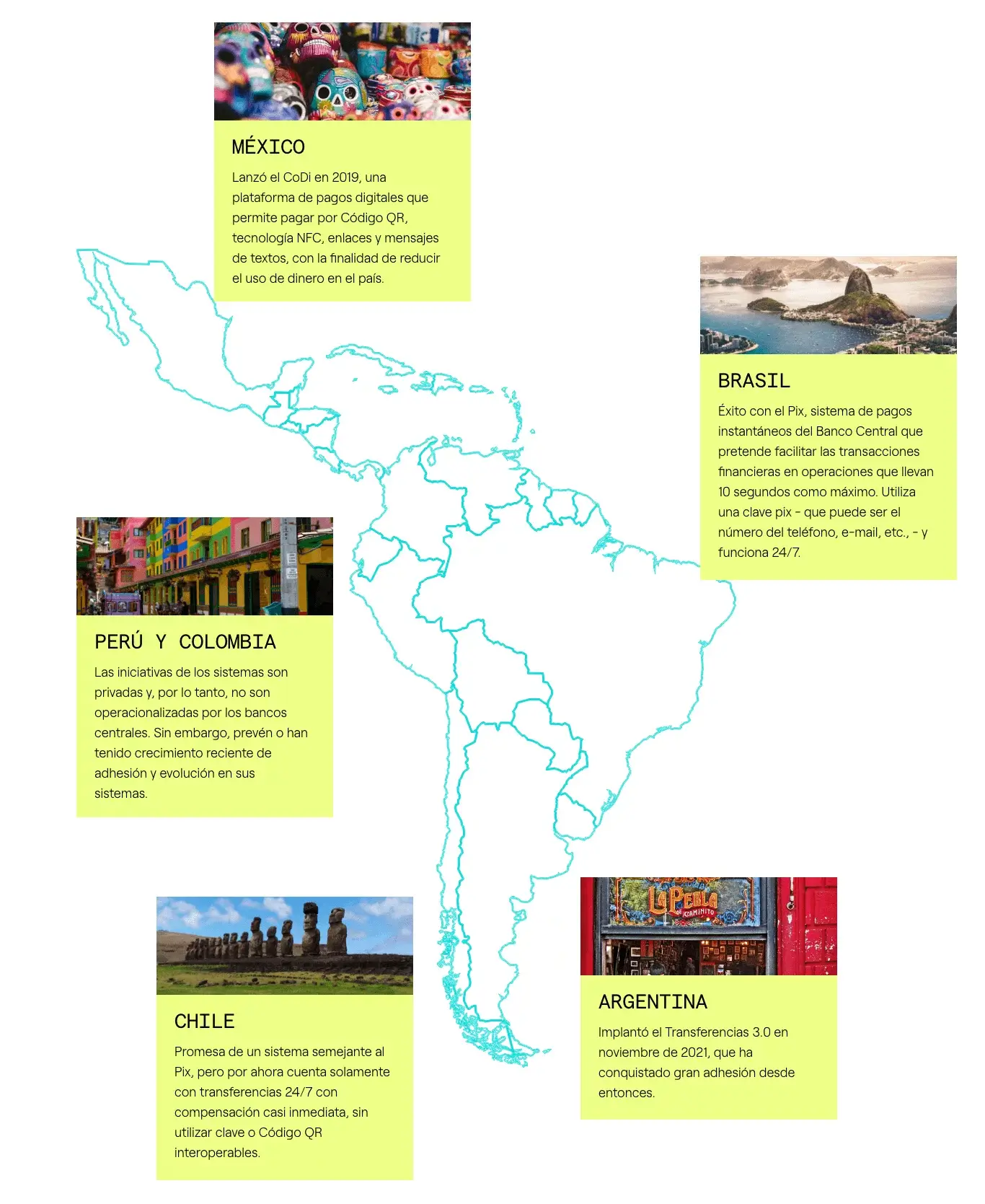
Contactless payment
In many countries, contactless or NFC (near field communication) payment took off with the onset of the pandemic. This was largely because it enhances the cardholder’s safety, as no direct contact is required to make a purchase, enabling social distancing.
In Brazil, in the first quarter of 2020, contactless payment transactions saw 456% growth, according to the Brazilian Association of Credit Card Companies and Services (ABECS). As for 2022, a study by Dock indicates that around half of in-person transactions will be made using contactless cards by the end of the year.
Payment link
Also among the digital payment methods that have been gaining strength in recent years is the payment link. The procedure is simple and practical: the link is sent by message or through social networks and the buyer opens it and makes the payment.
This is an alternative for capturing sales, without the retailer needing a website, physical store or card machine to sell their products or services. Due to this ease of use, the payment link is also a solution widely used by small and self-employed entrepreneurs and offered in PJ digital account solutions.
QR code payment
Another option for paying without any physical contact is the QR code, whose use was boosted during the pandemic in YouTube live streams and the activities of social media influencers. In some countries, QR codes are used to advertise brands and encourage people to buy products via apps, as all the user has to do is scan the code that appears on the screen by positioning their device so that it appears in their digital viewfinder.
However, QR codes can also be used at points of sale, simplifying the retailer’s relationship with different players in the payment chain.
In Brazil, the QR code is one of the ways Pix instant payments can be made at commercial establishments.
Private label cards
In the six countries analyzed in the study – Argentina, Brazil, Chile, Colombia, Mexico and Peru – the large retailers already offer financial products under its brands, mainly private label cards.
Thus, there is an opportunity both to provide improvements to existing offers and to expand this relationship with customers via “as a service” solutions (such as Banking as a Service, Acquiring as a Service , between others). Currently, most retailers restrict themselves to offering discount cards and loyalty programs and, to a lesser extent, other credit products.
Biometric payment
Among the means of payment technologies that have been boosted by the pandemic, is also advancing the biometry – but still with few use cases. This method can use fingerprint, voice, facial recognition or iris scanner. Therefore, it can be used in different contexts, especially as a way of authenticating operations.
Solutions involving biometrics are already being explored in different countries and are expected to grow. According to the data gathered by Dock, 43% of Colombians expect to use biometric payment in the near future.
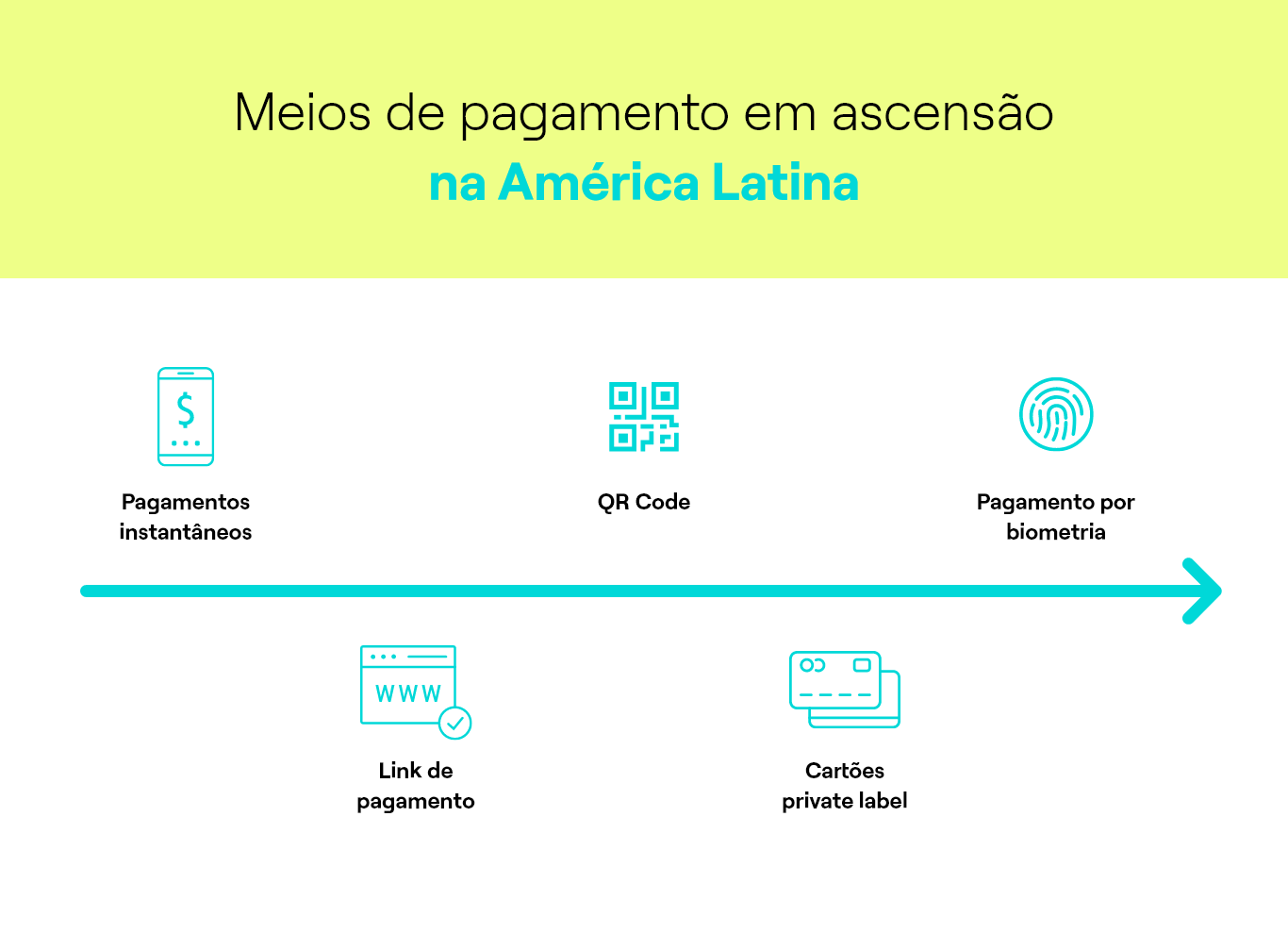
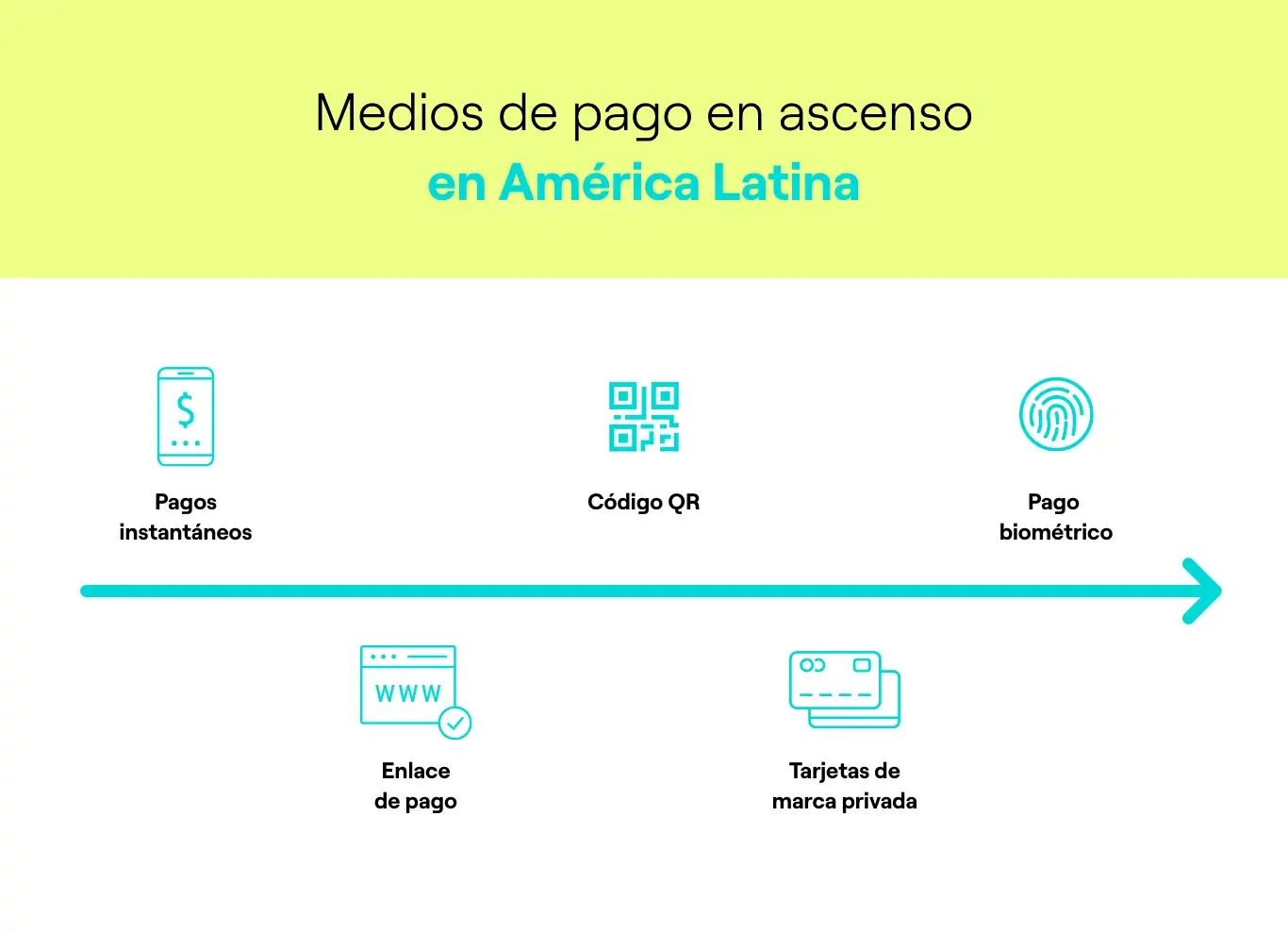
The size of the unbanked population is the biggest challenge facing the digital payments market in Latin America
In Latin America, alongside the widespread preference for cash, the Dock study reveals that 54% of the population do not yet use any banking services or digital methods for their financial transactions.
Another finding was that in Latin America today, there’s a lag between the technology and its use – i.e., digitalization is way ahead of bank service utilization. Although a wide range of modern payment methods are on offer, they are still severely underutilized.
In fact, this is the biggest hurdle facing the payments market in the region. While digitalization is growing apace, the financial inclusion of the population is lagging way behind.
- 71% penetration of smartphones in 2020
- Just 20% use the internet for financial services
- Just 12% use the internet to sell products or services
One factor influencing this scenario could have to do with the fact that the region’s high digital adoption is related to its age demographics. In Latin America, 58% of the population are between 18 and 44 years old. This is far different from the profile of the populations of Europe or the United States, for example.
Payment companies: the fintech boom in Latin America
One of the reasons why, with regard to the technological issue in means of payment, there is already great progress in the region is the high number of promising fintechs in these countries. In recent years, we have even witnessed a investment boom in Latin American startups in the sector.
So much so that Latin America has even been dubbed a “unicorn breeding ground,” having reached the end of 2021 with 41 unicorns, 14 of which are from the banking and payments market – the sector with the highest proportion.
Segments where unicorns are operating in Latin America
- Fintechs: 14
- E-commerce/Marketplace: 5
- logtech: 3
- ID Tech/Authentication: 3
- Food Tech: 3
- Others: 13
In addition to the evolution of fintechs in the region, there is another phenomenon that has been driving the volume of means of payment companies in Latin America: the embedded finance. Through it, companies whose core business is not financial, they start to add solutions with this profile as another source of revenue and engagement of their audiences.
This is the case, for example, of retailers with private label cards, from industries with digital accounts to their partners and suppliers, among others. So, no matter the segment, any business can be a means of payment company.
Read also API Economy: the engine for digital transformation and profitability of the New Economy
Latin America’s payments market: why it’s a land of opportunity
Dock chose the name of its study for a good reason. Latin America really does offer lands of opportunity.
Granted, there is still a long way to go: post-pandemic recovery of economic growth and the population’s moderate optimism about these better times; significant barriers facing new business ventures; a long way to go to achieve full financial inclusion – and others.
So why is it that we see these six Latin American countries as Lands of Opportunities?
The answer can be encapsulated in nine elements, which are already propelling the banking and payments sector:
- Financial education and offline strategies to boost financial citizenship and expand the customer base
- Growth of Buy Now, Pay Later and its contribution to financial inclusion
- Provision of financial services by retailers and companies from other segments through the phenomenon of embedded finance
- Expansion of e-commerce and increased card payments
- Digital payment options for use in e-commerce
- Instant payments, at different phases of implementation in the different countries analyzed
- Good overall conditions for doing business in Mexico, Chile, and Colombia
- Arrival of foreign fintech companies, helping to develop the Latam market
- Turning point in the Peruvian market, with incentives for digital banks
In addition, we cannot fail to look at the recent history of this market which, despite the differences between countries, has been participating in a global innovation agenda, which includes the advancement and flexibility of regulatory issues and the evolution of themes such as open Banking, CBDCs and instant payments.
Below, we comment on each of these drivers of the Latin American market. Want to discover the others? Access Lands of Opportunities in full.
Financial education and expansion of the financial system to overcome challenges
Finally, the study of Dock also highlighted the demand for a financial education content broad and accessible, with an approach not only online, so that the most vulnerable populations are also benefited.
Some initiatives to reach out to people with little or no access to financial services and the internet have proved very effective. Fintech and retail companies have adopted effective offline strategies in physical stores and in the press and mainstream media.
The fact is that while these players can benefit from the great opportunities Latin America offers, they themselves also have an important role to play in the region’s development. After all, as we have seen, digitalization is something that supports financial inclusion, but is not a determinant of it.
To get more Latin Americans involved in the financial ecosystem, it must become more competitive, offering more accessible customer-centered services, encouraging innovation, and expanding the payment and collection infrastructure.
BNPL
O Buy Now, Pay Later (BNPL) is a major trend for the Latin American means of payment market and promises to move the region's economy. Linked to the e-commerce boom and the model's worldwide expansion, the solution is expected to grow a lot in the coming months.
BNPL is a credit solution that enables low- and mid-ticket products (like domestic appliances) to be paid for in installments. This means that in countries where unemployment rates are high, low-income individuals can still obtain durable goods and keep the economy rolling.
Although BNPL is a credit solution and so does entail credit checks, there are already some players – in Mexico, for example – where these checks are done without examining bank or financial service data. They use different information, like telecom data, so even people who don’t have a bank account or work in the informal economy can still gain the benefits of this means of payment.
E-commerce on the rise
Like everywhere around the world, Latin America also witnessed a surge in e-commerce during the pandemic. And even since the public health crisis ended, this new habit shows no sign of abating; in fact, it’s expected to continue to rise.
It’s estimated that by 2024 the market will have grown by 29% and be worth US$ 580 billion, driven mainly by Brazil and Mexico. That means that there is a great deal of room for financial service businesses to also grow by offering solutions and services tailored to this market.
Good time for new foreign entrants
In its study, Dock detailed not only the evolution of technology for financial services, the digitalization of means of payment, and the exponential growth in the number of fintech companies in recent years, but also identified a marked presence of foreign companies operating in the Latam market.
One indicator of the scope of opportunity for new entrants in the region is the estimate that by the end of 2022, one third of Peru’s fintech companies will be foreign. Another is the high absolute number of foreign fintech players operating in Mexico (91) and the fact that 8% of Colombia’s fintech companies are international players.
And the means of payment in Brazil? Accelerating financial inclusion and advancing the transformation innovation agenda
Despite still having a long way to go in terms of financial inclusion, Brazil is the country with the best banking rate among the largest economies in Latin America. In addition, access to banks and fintechs through digital accounts increased significantly between 2017 and 2021 in the country, reaching 88% penetration among the population.
However, in terms of mobile internet adoption, Brazil is the third largest, that is, in this sense, the level of digitization still needs to improve to ensure that, in addition to the possibility of having an account, the population can use it regularly to make payments and other transactions. In 2020, mobile internet penetration was only 62%.
More specifically in relation to means of payment, the study shows that the credit card is the biggest highlight and continues to grow in the country. Both in electronic commerce and in physical points of sale, its use is superior to the other countries analyzed by the study Lands of Opportunities.
Main means of payment in e-commerce in Brazil
- Credit card: 43%
- Digital wallets: 17%
- Debit card: 13%
- Bank transfer: 8%
- Postpaid card: 12%
Main means of payment at the POS in Brazil
- Money: 35%
- Credit card: 34%
- Debit card: 20%
- Digital wallets: 8%
- Financing at the POS: 4%
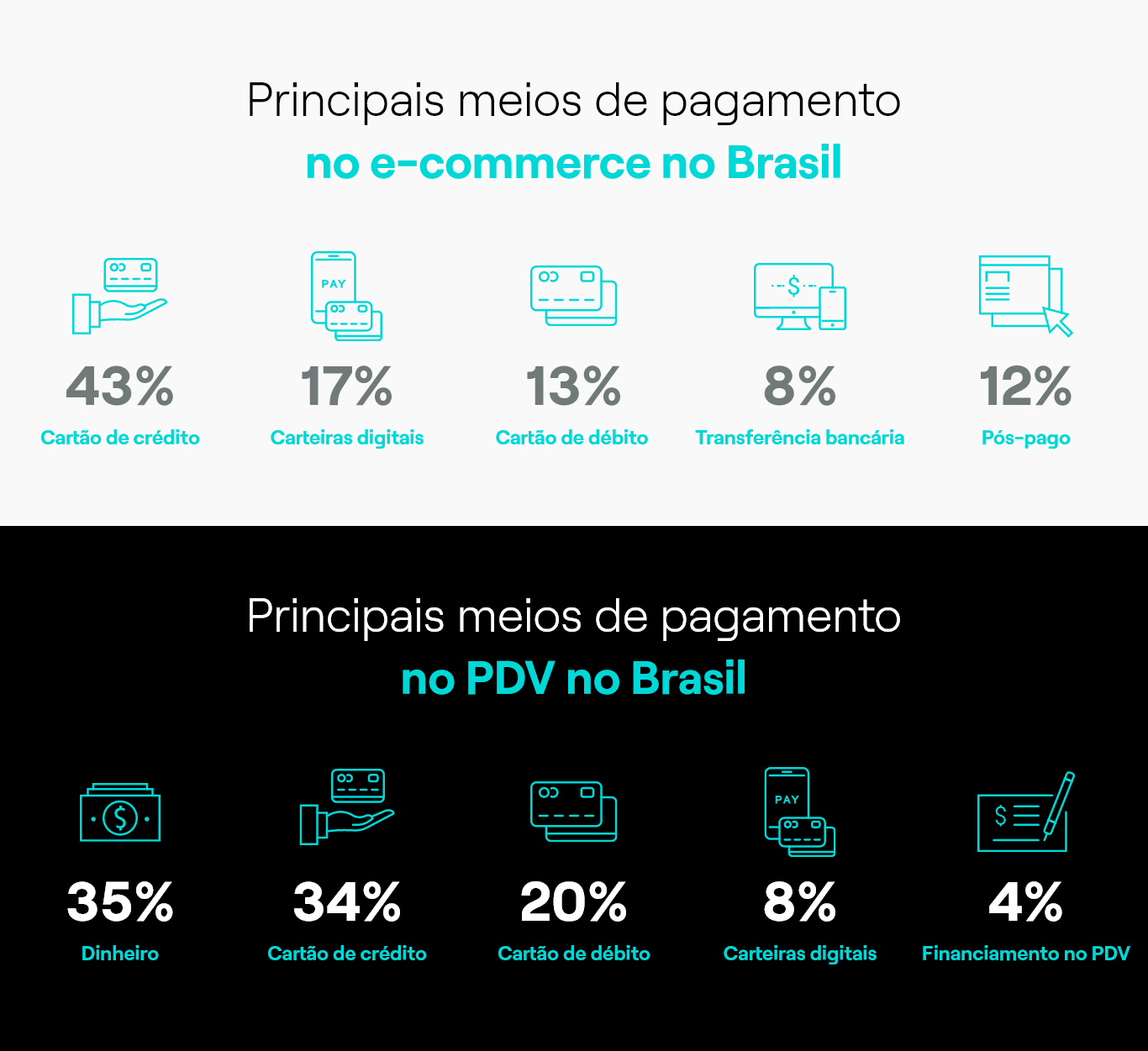
Finally, it is worth noting that another means of payment that is growing more and more in the country, as already mentioned, is the Pix🇧🇷 According to Bacen statistics, around BRL 9,5 million were transacted in 2021, with increasing acceptance in retail and e-commerce.
This is an advance that is directly connected to the BC# schedule – the institution's innovation agenda, which also includes other projects such as the Open Finance and Digital Real. In other words, we will still see more transformations over the next few years in the Brazilian market.
Do you want to check out the study Land of Opportunities – A map for means of payment and digital banking in Latin America in full? Access the material here!
Means of payment in Latin America: there’s a great revolution going on in the region
And it’s not just in how we do banking!
We believe that with the evolution in means of payment and increased financial inclusion, Latin America will see a tangible difference in its social and economic development.
Actually, it’s already happening. For example, with the rise in the number of bank account holders, thousands more Latin Americans were able to receive government payouts at the beginning of the pandemic.
Also, financial services are now managing to reach places and people that didn’t traditionally have access to them. Citizens with no means of proving their income have begun getting access to credit; people with no proof of residence can open a digital bank account to do financial transactions; micro and small businesses can take advantage of new payment solutions, helping boost their sales.
We invite you to join us in this transformation!
Means of payment in Latin America: what we covered in this article
- Means of payment are the different ways a product or service can be paid for. They include credit and debit cards, cash, instant payments, and others.
- Latin America is a region with great opportunities for the banking and payments market because of factors such as the high demand for financial inclusion, the growing digitalization of the population, and the fintech-friendly business environment.
- The growth of fintech companies in Latin America has been a driver for means of payment, as has the advent of embedded finance, which allows businesses from different market segments to “be a bank” and offer their customers financial solutions.
- Some of the latest advances in the Latam banking and payments market are: financial education; new credit solutions like Buy Now, Pay Later; the arrival of new international entrants; the rise of e-commerce and new regulations.
Related articles: